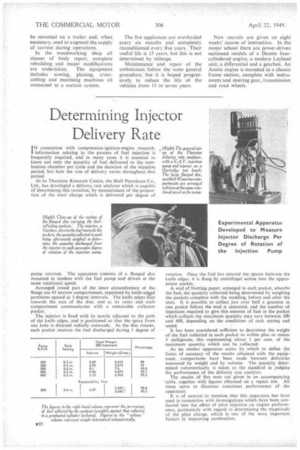Determining Injector Delivery Rate
Page 18

If you've noticed an error in this article please click here to report it so we can fix it.
IN connection with compression-ignition-engine research, information relating to the process of fuel injection is frequently required, and in many cases it is essential to know not only the quantity of fuel delivered to the combustion chamber per cycle and the duration of the injection period, but how the rate of delivery varies throughout that . period.
At its Thornton Research Centre, the Shell Petroleum Co., Ltd., has developed a delivery rate analyser which is capable of determining this.variation, by measurement of the proportion of the total charge which is delivered per degree of pump rotation. The apparatus consists of a flanged disc mounted in tandem with the fuel pump and driven at the same rotational speed.
Arranged round part of the inner circumference of the flange are 45 narrow compartments, separated by knife-edvd partitions spaced at 1-degree intervals. The knife edges face towards the axis of the disc, and at its outer end each compartment communicates with a removable collector pocket.
The injector is fixed with its nozzle adjacent to the path of the knife edges, and is positioned so that the spray from one hole is directed radially outwards. As the disc rotates, each pocket receives the fuel discharged during I degree of rotation. Once the fuel has entered the spaces between the knife edges, it is flung by centrifugal action into the appropriate pocket.
A wad of blotting paper, arranged in each pocket, absorbs the fuel, the quantity collected being determined by weighing the pockets complete with the wadding, before and after the tests. It is possible to collect just over half a gramme in one pocket before the wad is saturated, and the number of injections required to give this amount of fuel in the pocket which collects the maximum quantity may vary between 100 and 400, depending on the conditions of rack setting and speed.
It has been considered sufficient to determine the weight of the fuel collected in each pocket to within plus or minus 5 milligrams. this representing about 1 per cent of the maximum quantity which can be collected.
As no similar apparatus exists by which to define the limits of accuracy of the results obtained with the equip-. ment, comparisons have been made between detiverieS measured by weight and by volume. The quantity determined volumetrically is taken as the standard in judging the performance of the delivery rate analyser. The results of five tests are given in an accompanying table, together with figures obtained on a repeat test. All these "serve to illustrate consistent performance of the apparatus.
It is of interest to mention that this apparatus has been used in connection with investigations which have been conducted into the effect of pilot injection on engine performance, particularly with regard to determining the magnitude of the pilot charge, which is one of the most important factors in improving combustion.


























